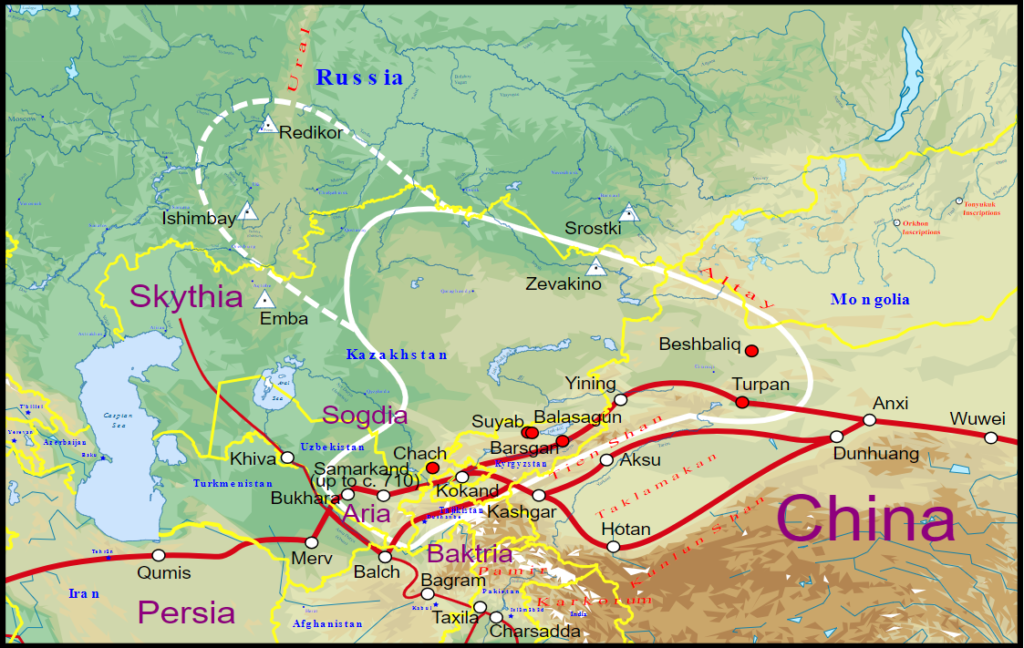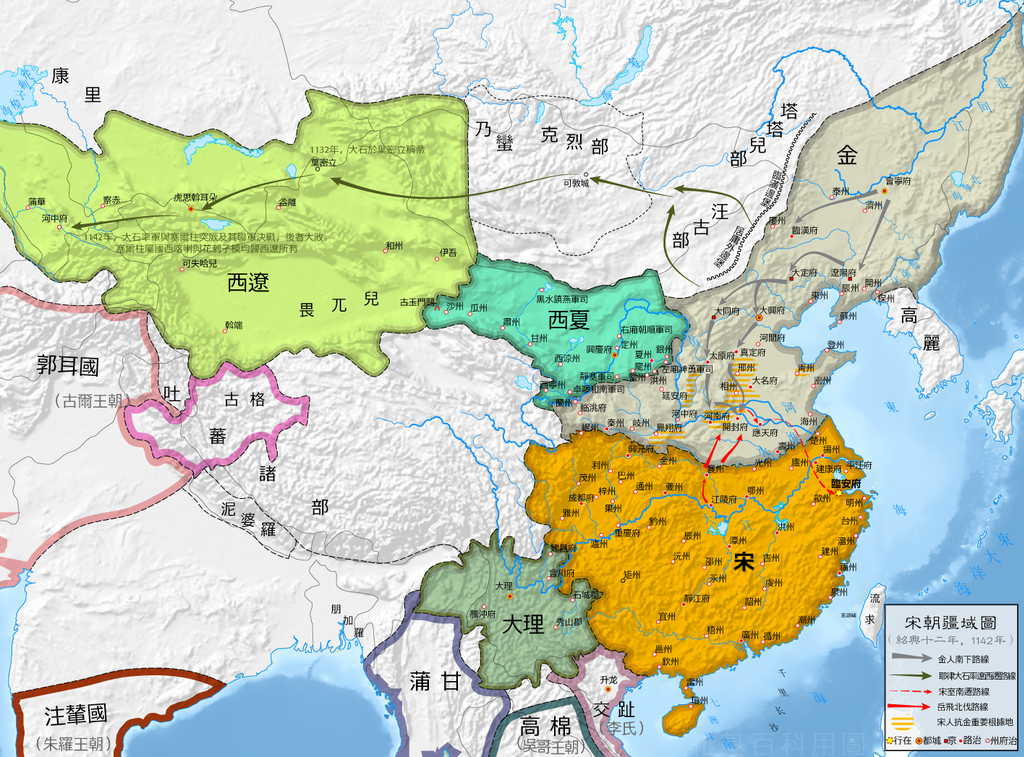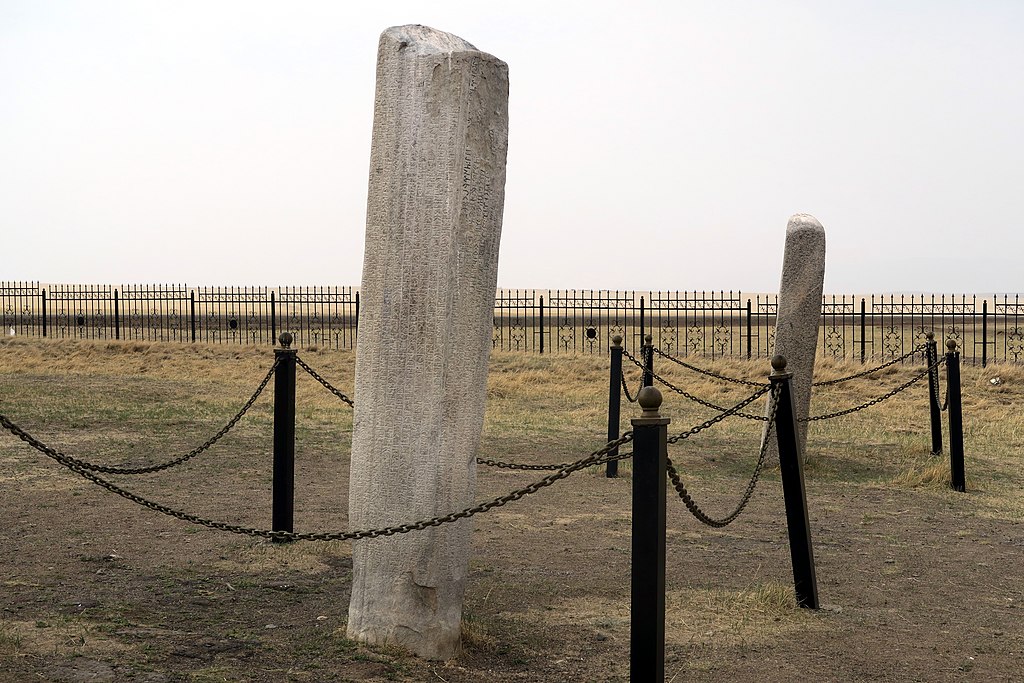(عربي) The eastern side of Orkhon inscriptions’ stone starts by the following:
“To the East I have made campaigns as far as the Shantung plain, and almost reached the sea; to the South I have made campaigns as far as Tokuz-Ersin (?) and almost reached Tibet; to the West I have made campaigns beyond Yenchii-iiguz [“ The Pearl River ”] as far as Tamir-kapig [“ The Iron Gate ”]; to the North I have made campaigns as far as the land of the Yer-Bayirku’s”

Liquified Borders
Despite the vast geographical area that’s covered by this description, the real events described in the inscriptions do not go that far and include a smaller area. The map (Wikipedia) below can show similar geography and can clarify the locations of some areas mentioned in Orkhon inscriptions, although the map is of Turuges khaganate. Political maps of khaganates show interference in time and regions of Khagantes. The frequent mention of battles with the same neighboring groups gives an impression that there are no long-term borders between these groups if any borders existed at all, but it is no more than overlapping circles of power.
The Khagan could fight in a battle at a specific point then he would mention that he made a victory against the Karluks near Beshbaliq, for example, but was Beshbaliq always part of the Gokturks reign? Did the Khagan leave as soon as he made a victory? This is not clear, but he mentions that Beshbaliq was saved. It’s also unclear whether a specific village or town had been taken by another rival tribe or tribal confederation later. This is an example of how the locations are mentioned. The text isn’t very objective and it’s not an accurate record of geopolitical changes. Another example is about a battle that happened near Iretish river which is located in the north of current Kazakhstan, but was that part permanently belonging to the second Turkish khaganate? That’s not clear too.
Based on the inscriptions, the only certain thing is the Gokturks had lived in the Orkhon valley near Tuul river during the reign of at least 4 continuous Khagans. Many battles and events are mentioned to be happening around that area too, which shows that the conflicts with other rivals could go as far as the heart of the Khaganate, which also confirms the concept of the liquified borders of nomadic peoples’ states.
Peoples and groups mentioned in Orkhon inscription and their existence today
It’s difficult to confirm whether some of the groups that were mentioned Orkhon inscriptions are the ancestors of groups that hold the same names today. However, the names of these groups are unlikely to have been changed for some of them like the Kyrgyz. Locations of the Turkic peoples were always subject to the fact that they were nomadic people. Although locations may still be changing within a specific geographical area, that range could change within a few hundred years. Extinction seems to be the fate of many groups, which is the other fact that is often ignored in a history that ignores the shadows and focuses on the victorious and those who exist today as ethno-linguistic groups.
Oghuz is one of the main groups that are mentioned in the Orkhon inscriptions, they are supposed to have lived to the north of Mongolia. Today, the term Oghuz refers to a sub-branch of the Turkic languages family and it includes those who live in Anatolia, Iran, Azerbaijan, Turkmenistan, and the Gagauz in eastern Europe. But were the Oghuz in the inscriptions the same as today’s concept of Oghuz? In the text, we can notice the Tokuz Oguz (nine Oghuz) or the Otuz-Oguz (thirty Oguz), and Oghuz only refers to a community or group. We can also notice that the Uyghur are one of the nine groups that form the confederation of the Tokuz Oguz according to the old book of Tang, and it’s known that the Uyghur’s language is classified within the Karluk sub-branch, not within the Oghuz. However, if today’s Oghuz is really the descendants of the Oghuz who lived to the north of the Gokturks, then it means they migrated for no less than 5000 kilometers, divided into 6 groups – if we view that linguistically and geopolitically – and they formed powerful states on the other side of the world. All that happened about 400 years after the inscription’s date.
The Tokuz Oguz groups on the other hand, if they were really representing different linguistic groups, don’t seem to have stayed as independent groups or to have preserved their languages or their existence as independent groups. The location of the Tokuz Oguz according to the inscriptions was supposed to be in some area near the current region of the Uyghur today or within Gobi desert. The inscriptions also mention the Tokuz Tatar (nine Tatars), and there’s nothing known about this group’s language or location and no more elaboration in the inscriptions other than mentioning their name.
Even though the Uyghur who are known today to be speaking a language classified within the Karluk branch, the Karluk seem to be a different independent group in the inscriptions. Karluk today covers Uyghur and Uzbek and formerly included extinct languages such as the Chagatai, Khorezmian, and Karakhanid. The inscriptions didn’t mention the location of the Karluks. Karluks enjoyed a golden era following the Mongolian conquests, but today there are only two ethnic groups that speak Karluk languages, which was the case in the Orkhon inscriptions where there was an eastern point that belonged to the Tokuz Oghuz, and a western one that is known as the Karluks.
Sogds were mentioned multiple times, Persians once. The location of Sogds and Persians is specified near Temir Qapiy (Temir qapïγ) which was somewhere between Balkh and Samarkand. Persians’ populations in these areas are very limited today, while the Sogds have been extinct as a linguistic group.
Kitays are one of today’s Mongols’ ancestors. According to the inscriptions they lived to the east of Orkhon valley. Sometime after the inscriptions, the Kitay’s flourished under the Jin dynasty in China. Kitays were mentioned in two contexts, the first was a dangerous scenario, in which Oghuz, Kitays and Chinese unite and end the existence of the Gokturks; the second scenario, is where they were co-mentioned with Tatars and Tatabi twice. Tatabi’s seem to be another Mongolian group that existed until the end of the first millennium, and Tatars spoke a Turkic language but they were often in the same side with the Mongols. The Arabs, mistakenly called the Mongols Tatars. Today, the Tatars have higher population and area of spread than the Kitays (if we considered Kitays the official ancestors of the Mongols).
Kyrgyz were a significant enemy to the Orkhon Gokturks. It’s unclear where they were living, but in one of the mentions, the way to the Kyrgyzs was blocked by snow. The inscription mentioned that they lived in Kogman forests and mountains, which don’t exist anymore under that name, but from the nature of the location, it seems not to be very far from today’s Kyrgyzstan mountainous area. Kyrgyzs are often mentioned with the Az people who are extinct today. Chik people were also mentioned as allies of the Kyrgyz but without details about them. Similarly, other groups were mentioned with no information such as the Bashmil people, Chugay-Kuzi, and Apar.
Tardush and Tolish seem to be part of Xueyantuo tribe according to a Wikipedia article and they weren’t real groups but a divisions or administrative parts within that tribe’s Khagante, that indicate to the unclarity of the surrounding groups even to the Gokturks.
Other extinct or merged groups are the people of the ten arrows who were part of the Noshibi people and they lived in the western Turkish Khaganate, Turuges weren’t known anywhere except in the inscriptions, Izgil also seem to be an extinct group, as well as the Adiz people and the Tangut people who seem to be a Sino-Tibetan speaking group that was mascaraed and subjected to a genocide by the Mongols.
Tanguts, Tibetans, Sogds and Chinese are the only non Turko-Mongolian groups that are mentioned in the inscriptions and seemed to be part of the political world of the Gokturks. But Chinese were the most frequently mentioned ones. Many battles happened with the Chinese for example. The Khagan also seems to be boringly repeating the fact that he asked the Chinese emperor to send him some artists and the emperor accepted; he mentioned that many times. The inscriptions also talk about the fortunes of the Chinese, their silk, silver, and gold. The Khaganate seem to have never achieved a successful attack into the depth of China.

Sample of the inscriptions writing along with the translation to English:
𐱃𐰸𐰆𐰕:𐰆𐰍𐰕:𐰉𐰆𐰑𐰣:𐰚𐰤𐱅𐰃:𐰉𐰆𐰑𐰣𐰢:𐰼𐱅𐰃:𐱅𐰭𐰼𐰃:𐰘𐰃𐰼:𐰉𐰆𐰞𐰍𐰴𐰃𐰤:𐰇𐰲𐰇𐰤:𐰖𐰍𐰃:𐰉𐰆𐰡𐰃
Toquz Oγuz budun kentü budunïm erti Teŋіri jer bolγaqïn üčün yaγï boltï.
“Nine Oguzes were my own people. As Tengri and the earth came to disorder, they rose against us.”
